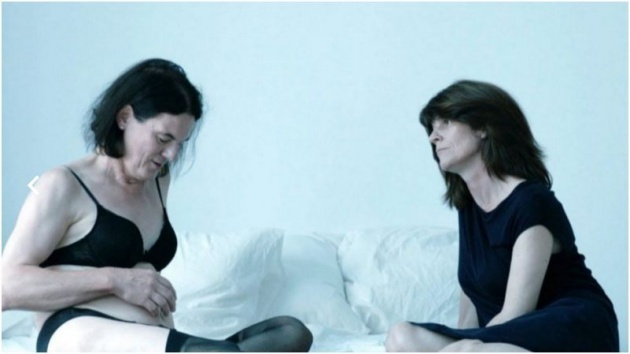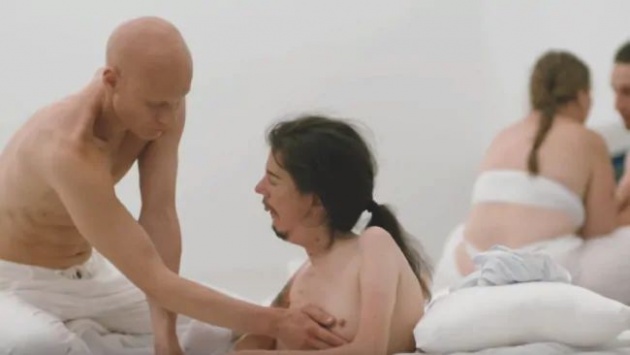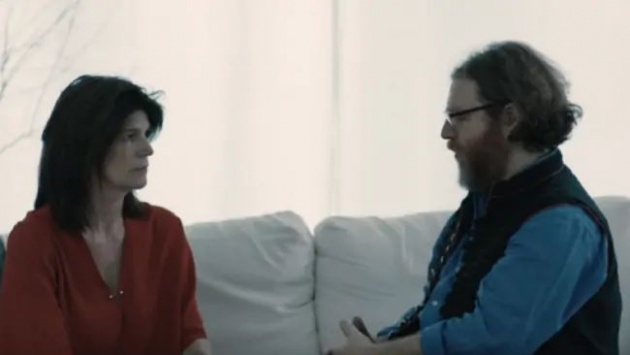
Pictured: 'Therapist' Hanna Hoffman offers Laura (Laura Benson) some intimacy tips in 'Touch Me Not', an investigation into intimacy aversion directed by Adina Pintilie. Still courtesy of MUBI
‘You never asked why I am making this film.’ Director Adina Pintilie makes this statement in voice-over shortly after the start of her study of intimacy aversion, Touch Me Not. The first time I saw the film on the night it won the Golden Bear at the 2018 Berlin Film Festival, I thought it was addressed to her subject, Laura Benson, a fifty-something Englishwoman who cannot bear to be touched. In fact, as we discover later, it is directed to Adina’s mother. Adina relates to Laura a dream that in which her mother turned up in her bedroom. Adina banishes her from the apartment but then she appears on the balcony - or rather the ‘curse-word’ balcony.
When I first saw the film, I thought it was a documentary, or at least it had documentary elements – Laura resisting a male hand wandering downwards from her solar plexus. ‘How does that make you feel?’ the male therapist, Seani Love, asks as he tests Laura’s physical limits. ‘It makes me feel ... uncomfortable.’ This might win an award for the ‘no sh-t, Sherlock’ school of obvious dialogue, but both Laura and Seani are utterly believable. As Laura fends Seani off and roars at him (‘a very powerful roar,’ Seani remarks) I felt I was watching a scene played out for real in front of my eyes.
Laura has a face that suggests that she has winced more than smiled. Her wrinkled hands have spent too much time underwater, scrubbing clothes or washing dishes. However, her body is spectacularly beautiful. Although Laura cannot bear to be touched, she allows the audience to see her naked.

Pictured: Tómas, a man with alopecia touches Christian, a man with spinal muscular atrophy in 'Touch Me Not', a study of intimacy aversion by director Adina Pintilie. Still courtesy of MUBI.
Laura is old enough to be Adina’s mother and so seems to me some form of surrogate: the mother who didn’t show enough physical love towards Adina, who didn’t ask her about her movie.
The documentary style is underscored by the camera following Laura as she visits a medical facility. A tune is hummed on the soundtrack that we discover accompanies the line ‘melon, melon, melon, melancholia / Melancholia’. Laura looks in on a physical therapy class in which the participants are all dressed in white. Amongst them are Tómas, a man with alopecia (that is, he has lost all his body hair) and Christian, a man who has spinal muscular atrophy. In one exercise, Tomas closes his eyes and touches Christian’s face. Christian is drooling, an effect of his condition. After Tomas is asked how he felt. ‘The face ... it’s very intimate.’ Transcribed, the response seems banal, but Pintilie is showing us the difficulty of finding words to describe physical contact without pleasure.
When language expresses sensory gratification, the words come easily – she is beautiful, the painting exquisite, the meal lovely. Tomas could describe the sensation of touching Christian’s facial hair (furry) or skin (rough) but the therapist is encouraging him to ‘feel’ deeper, to imagine how Christian might feel being touched. When a response is no longer your own - you are imagining the reaction to your gesture - the description becomes more tentative, looser.

Pictured: Laura (Laura Benson) gets physical with Seani Love (himself) in 'Touch Me Not', a cinematic study of intimacy aversion from Hungarian-born director Adina Pintilie. Still courtesy of MUBI
Laura follows Tómas while Tómas follows another woman, one who leaves a possession at a café, one that Tómas picks up. There is a payoff for Laura as she gets to see Tómas naked. Tómas asks her to sing him a lullaby. The only one Laura can think of is a ballad about a prostitute. However, he sings her a proper lullaby.
Is Laura’s aversion to touching men or being touched by them? Right at the start, Pintilie’s camera travels up the leg of a naked man. It takes in (as it were) his curled up penis. Later Laura will watch a man undress and masturbate. We don’t see him ejaculate. Then she watches him shower and ask about his tattoo. What language is it written? ‘Bulgarian.’ Did he write the words himself? ‘No, it’s from a book.’ ‘What does it say?’ The man doesn’t explain. Literature is normally something discussed fully clothed.
Laura, or at least her character, has father issues. Late in the film, she visits an old man in hospital and breaks a record in front of him. A nurse is required. The inference is that her father made her wary of men, resistant to finding comfort in a man’s body. But she – or rather her character – does not desire women. Rather she is dealing with a phobia. It could be snakes or spiders, but just happens to be a man.
In one of the more amusing sections, Laura consults Hanna Hoffman, a transsexual who conducts therapy sessions in women’s underwear. She enjoys her own body and encourages Laura to look at it. She has named both of her breasts. She listens to classical music.
Almost inevitably, we end up in a sex club in which one woman is strung up in bondage and hangs upside down. According to a caption at the end of the film, no one was harmed in the scenes of masochistic sex play, though I wonder about the disclaimers signed by the participants: were they signed before or after? At any rate, there are no faces fuzzed out by pixels. Everyone must have been content to be shown in a sex club.
The film is entirely in English though it is never clear where it is set. Actually, it doesn’t really matter as it is all a construct. Early on we see a glass placed in front of the camera onto which is projected Adina’s face. This allows the subject, recorded by the camera, to talk to Adina. At one point, Adina sits in front of the camera and feels awkward; Tomas steps behind it.
By the end, Laura is seemingly liberated, happy to dance around the room naked. Christian is in a nurturing relationship with Girt, who appears to be his nurse. They are intimate in spite of his spinal muscular atrophy. Tómas may have ‘unblocked’ Laura, though it is unclear whether his issues are solved. Still, two out of three isn’t bad.

Pictured: Girt and Christian in 'Touch Me Not', a film by Adina Pintilie. Still courtesy of MUBI
What of melancholia, the film’s refrain? The dictionary definition is ‘deep sadness, severe depression’. A treatment for melancholia is ‘music and dance’. This accounts for the film’s ending. With this in mind, we shouldn’t think of Laura’s naked dance as evidence of being cured, rather a continuing treatment. It is the means by which she can feel more comfortable around other people’s bodies. If nothing else, Touch Me Not illuminates a very real fear of being touched that we should be sensitive to, even though it achieves this aim entirely through artifice.



